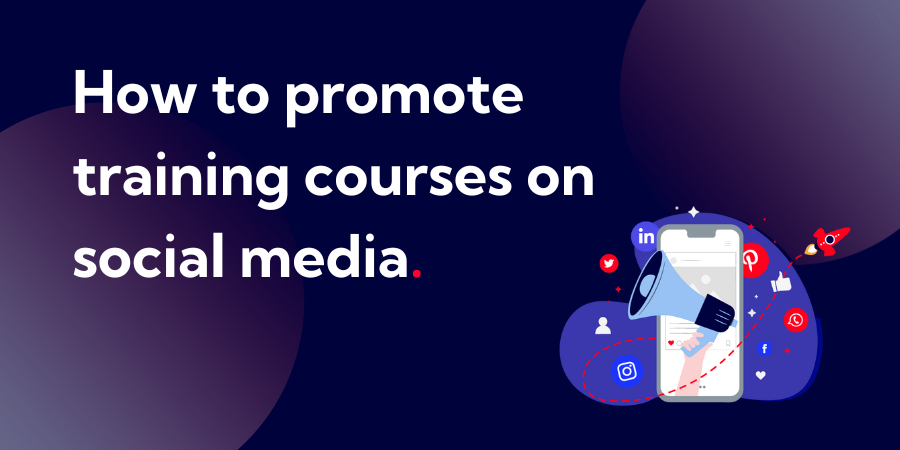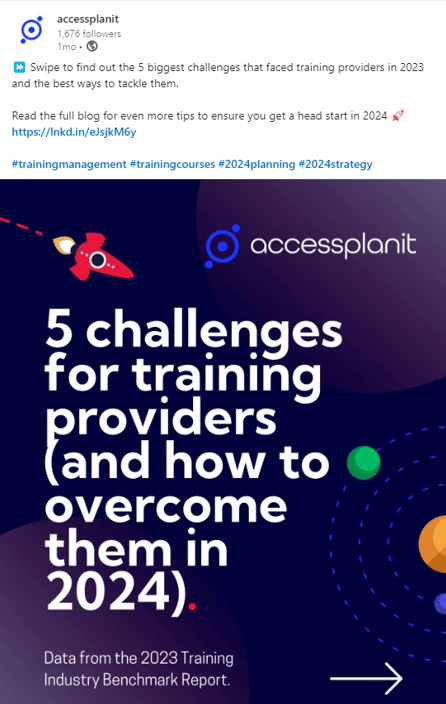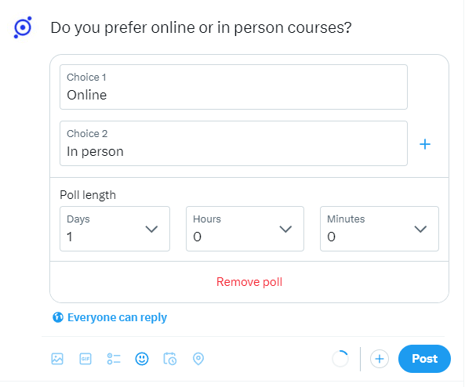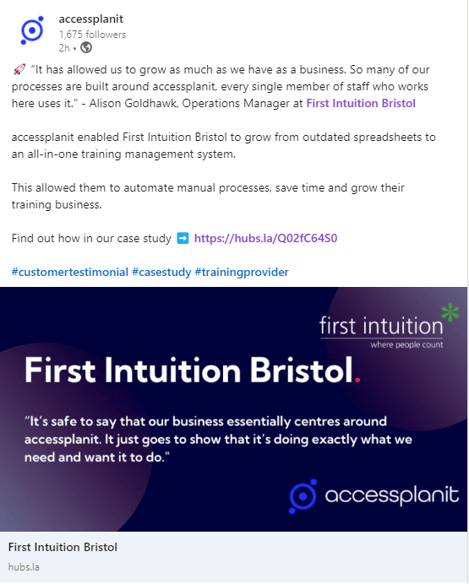How to promote training courses on social media

Making your training courses stand out in a competitive market is a challenge that all training providers face. You know that your online or in-person courses are amazing, but how do you make sure that everyone else does and get those all-important bookings?
Social media marketing should be a part of your training course marketing strategy. This is because social media marketing for course promotion can be highly effective in increasing course bookings - and you might not even have to spend a penny.
With billions of daily users, how do you make the most of this opportunity and promote courses on social media for free?
In this blog, we’re going to run down 12 tips that you can use to promote training courses on social media, including content ideas and examples. These helpful hints include things you may not have thought about before, but can be implemented immediately to improve your social media strategy, boost course bookings and grow your training company.
12 tips to promote training courses on social media
3. Repurpose your content across platforms
4. Create community discussions
5. Use polls to engage your audience
6. Share customer testimonials
7. Reach out to similar accounts for partnerships
11. Keep a finger on the pulse of trends
12. Don't forget about the lesser-known platforms
1. Know your audience
Before you can start to promote your courses on social media, you need to know your audience inside out.
Picture your ideal customer. Is it an individual delegate, or perhaps a large client? What are their current education levels? What are they trying to achieve from your training course? Where are they based? The more specific you can be at this point, the better.
If your training business is fairly established, you probably have an idea of this already – great! If not, it's time to get this nailed down.
This is because, by understanding your audience, you can begin to understand what content they would find valuable and tailor your social media marketing around this. Your audience needs to find your content interesting to engage with it, so make sure you have a strong understanding of your demographic and the type of thing they want from their social media experience.
This might include tips relating to your course topics that your audience can action, or free resources from inside the course.
2. Create video content
Social media is dominated by video content these days and it is essential that you utilise it for the most engaging social media marketing strategy to sell your training courses. 92% of marketers say that they get good ROI from video content.
TikTok is a hugely popular platform (it has been downloaded 4.7 billion times worldwide), focused on short-form videos. Going viral on TikTok has proven to launch businesses to new heights, and it has even been touted as a more popular search engine than Google for some demographics.
Could you answer some of the questions being asked on TikTok, in a way that’s relevant to your training courses? If so, it could be an opportunity waiting to be grasped. Read more about TikTok for training course marketing.
It’s not just TikTok where video content thrives, though. Videos are popular with Instagram and Facebook’s algorithms (meaning they are likely to be boosted into people’s feeds). YouTube Shorts are also a growing medium that people are using to browse content.

Video content ideas
You could share interesting short snippets of your course to give people a taster, or an animated explainer video summarising the type of courses you offer and showcasing your USPs.
Don't forget that company culture content, such as videos of things your team gets up to in the office or 'day-in-the-life' videos, are easy to make and often perform well because they humanise your company. The screenshot above is an example of accessplanit's approach to this.
You could even try your hand creating funny content by recreating memes using viral sounds or getting involved in trends (more on this below!) as part of your course marketing strategy.
3. Repurpose your content across platforms
Remember that all content can be repurposed across multiple channels for maximum reach, allowing you to promote your courses on social media quickly and easily.
Related to the point above, practically any content can be repurposed to video. For example, this blog post could be made into a video with someone telling these tips to a camera, or by changing them into animated text.
I could then share the video on TikTok, Instagram, Facebook, X, LinkedIn and YouTube. I could also turn these tips into a carousel (which have high engagement rates).

Take note of your highest-performing content across your website and social media and think about how you might repurpose these into fresh content.
Don't worry about repeating yourself; as long as you leave enough time and aren't simply reposting the exact same content, your audience is unlikely to take note of similar content being repurposed. This is one of the easiest, yet most effective ways to boost engagement and promote courses online.
4. Create community discussions
The clue is in the name - it's called 'social' media for a reason! These channels are a great opportunity to connect with your current and potential customers. Make it a two-way discussion by responding to comments and messages. This humanises your training business and makes your company more approachable, encouraging enquiries and leads.
Making people feel like they are a part of an exclusive group can be a great way to do this, at the same time as fostering brand loyalty. Creating a community for your audience to interact with you and each other can help to drive conversations and meaningful relationships.
How to create community discussions
You might make a private Facebook or LinkedIn group or X Space for your existing delegates so they can connect with fellow students and chat about your courses. You could use this space to offer exclusive discounts or early access to your newest products, as a way to thank your most engaged customers. You could also post conversation starters or questions in these spaces to make your community active and engaged.
On the other hand, a simple way to build a community is to include a call to engage (CTE) on any of your captions (such as 'comment your thoughts') to encourage people to interact, and then respond to the comments. This gets the conversation rolling, which can boost your post into other people's feeds and promote your courses further.
5. Use polls to engage your audience
To help with the above, you should make use of the free polling tools that most social media platforms have built into them. These allow you to post a question that your followers can answer by simply clicking a button.
Not only is this a simple way to engage your audience, but it is an effective method of gaining audience insight. You can use this to gauge feedback on a new course, find out about their learner preferences, and learn more about their lifestyles and personalities.
Here are some ideas of poll questions you could ask:
- Do you prefer online or in person courses?
- Are you a visual learner, auditory learner or hands-on learner?
- Which of these course titles do you think sounds more intriguing?
- Do you prefer to book courses online, via email or over the phone?
- What is your budget for buying training courses?

The answers you get could provide interesting insight that could be repurposed into shareable content. It might even help to inform your business strategy.
But, if you just want to drive engagement, you could ask simple but divisive questions that encourage people to voice their opinions. Here are some examples:
- Tea or coffee?
- Dogs or cats?
- Is Die Hard a Christmas film?
If you can create polls that are relevant to current trends or debates – even better! The idea here is to get people interacting with your posts; this keeps your company front of mind and helps to boost your content into other people’s feeds and get the word out about your training courses.
6. Share customer testimonials
People are savvy to marketing. To build trust, it’s important to shout about your successes and attach real people to your training courses. Social proof is one of the most important forms of marketing that all training providers should use for course promotion.
You could do this by encouraging delegates to leave reviews on review sites and then sharing the positive ones across your social media channels, using eye-catching graphics that pull the most impactful quotes.
Or, you could contact your most loyal clients and ask them to take part in a case study or testimonial video. Be sure to tag them or their business in the post to encourage them to share it with their audience and increase the post's reach. To get an idea, have a look at accessplanit's case studies.
You could offer certain incentives for customers who help you to create testimonial content, like a gift voucher or discount on your training courses. Ensure your existing customers know about this via your website or using email marketing.

7. Reach out to similar accounts for partnerships
Reaching out to similar accounts and asking them to share your product works in a similar way to testimonials. This is due to the increase in trust when the message comes from a human source, making it an effective way to promote your course.
Influencer marketing is a very popular and effective method of social media marketing. It involves reaching out to someone with a large following, made up of people you would like to be your customers, and getting them to promote your training company on their channels.
This might cost you a one-off fee, or in exchange for free access to your course. Or, they might have an exclusive code or link to your website, and they get a percentage of the profits it generates.
Alternatively, you could reach out to businesses that are similar to yours and strike up a mutual agreement to promote each other’s products. For example, do you have a supplier that you could praise on social media, and ask them to share the post?
Exposure to a relevant audience, from a voice they trust, can be a great way to boost brand awareness for your training company online and increase course bookings. Not only is it sent straight into their feeds, but it shows them that someone they follow endorses them, leading them to be more confident in the quality of the course.
8. Test, test and test again
To get your social media marketing strategy right, it’s important to pay attention to your performance metrics. To optimise your posting strategy to promote your training course, you should run several tests to see what works and what doesn't. Here's a step-by-step guide to running social media marketing tests:
1. Get familiar with the tools
The first thing you need to do is familiarise yourself with the in-built analytics tools available on most social media platforms. They show you things like how many accounts your post reached, the engagement rate and view count, if relevant.
2. Choose a metric
Next, choose a metric that is most important for you to measure. If you are looking to increase brand visibility, this might be impressions. If you are looking to drive conversions, it might be click-through rate. These are your key performance indicators (KPIs).
3. Run the tests
Then, run the tests. Start by experimenting with different types of content. For example, did your repurposed carousel perform better than your video? Does your funny content garner more clicks than your informational content? Make a note of the type of content your audience values most and prioritise this going forward.
Also, pay attention to things like times and days of posting. Do your posts on Monday get far more views than those on Thursdays?
4. Track the results
Take the time to think about how you will track your KPIs - for example, by creating a spreadsheet to record weekly metrics. Be sure to track when you are posting, the platforms used, the type of content and all of your KPIs. When presented effectively, this can help you to check for patterns in the data and act on them.
By keeping track of your performance, you are better placed to tailor your training course social media marketing strategy accordingly with data-driven decisions.
9. Create a paid ad campaign
One of the best things about using social media to sell courses is that it is completely free. However, if you have a budget, you can also run paid ads on these platforms. Your chosen platform will display these ads to people they think are most likely to be interested in the content, which can really help to boost your visibility and bring in high-quality leads (people who are likely to book on a course).
You can choose to track certain conversions that matter most to you – such as the number of people who have clicked on the ad or who go on to make a course booking on your website.
Although this can get expensive, you have control over how much you spend by defining a budget. The platform then automatically allocates the money for you based on the preferences you define - such as a daily or weekly limit.
10. Tell a story
Posts that take a reader on a journey, with a clear beginning and end, are more likely to draw in an engaged audience. If you can tell a personal story about you, your brand or your customers, even better.
People love to hear stories - it's human nature. They give people a reason to keep reading and help to humanise your company, as they are often relatable or inspiring.
The most effective stories have a clear takeaway for the reader. This might be a moral message or how they can get similar results for themselves.
To capitalise on this, make sure every post has a call to action (CTA) at the end of it - giving the reader a clear instruction on what to do after they have read your post. This should be something they can do easily, such as follow a link, get in contact or book a place.
Storytelling ideas
As we have already talked about, testimonials make for great content and often involve storytelling, such as how a customer found your courses, their training journey and the results they had after they took the course.
For a quick post idea, why not post the story of why your training company started?
11. Keep a finger on the pulse of trends
It might seem like there’s a new hot topic every day in the world of social media, but don’t worry – you don’t have to get involved in all of them. In fact, it's better if you don't, as your social media content needs to be relevant to your audience.
But, if you can contribute something valuable, interesting or unique to the conversation, in a way that is relevant to your training business, do it! By getting involved in current trends, you are not just showing that your business is engaged on social media, but you may even go viral as a result and gain all-important brand visibility.
We particularly love SEMRush's approach to this:

Keep it relevant
Keeping up with trends isn't all about knowing what memes are currently doing the rounds or what's happening in pop culture. It's just as important to keep up with industry trends and discussions, which might not be mainstream but are more specific to your training company. These are the topics that you can offer the most value to.
Stay up to date with trends by being active on social media and locating and following experts, who might have a blog or newsletter. Why not start by subscribing to the accessplanit blog for training industry insight?
Most platforms offer you the ability to follow hashtags, so utilise this to follow words and terms to do with your industry. Join relevant discussion groups (such as the Training Provider Network) and monitor what conversations are being had.
Create unique and interesting content based on what your audience is currently talking about so that you can get in the conversation and establish yourself as a thought leader in your field using social media.
12. Don’t forget about the lesser-known platforms
When you think of social media, you’re likely to think of Facebook, Instagram, X and TikTok. But these aren’t the only valuable platforms with lots of users that you can use to promote your courses - and these popular ones might not be relevant to you at all, depending on your product. This again comes down to understanding your audience and where they are likely to be.
If your target audience is students looking to upskill, or professionals looking for certifications or compliance training, they are likely to use LinkedIn to look for growth opportunities, network with peers and keep up with industry trends. LinkedIn is often underutilised by businesses, but it can be an ideal place to sell training courses as it is full of potential delegates who want to build their skills and qualifications that they can show off on their profile. This is perhaps why it is used by 78% of training providers.

Or maybe your target audience is young people who are looking to start up a new business by developing a new skill? In this case, they might use Pinterest. This is a great fit if you have courses related to personal growth, DIY or fitness. Pinterest is often overlooked but it has 482 million monthly users.
Also, with the recent changes to X (AKA Twitter), a few alternative apps have popped up which are growing in popularity. You might want to tap into the potential of platforms like Bluesky or Threads – and you might find less competition in these newer platforms.
Want to learn more about accessplanit?
If you're interested in learning about using our powerful tools to grow your training business, why not book a demo with accessplanit today?
Our training management system allows you to forget about admin, automate your processes and free up your time to focus on marketing your training business effectively and growing your success.
Learn more about using social media to grow your training company in this webinar


.png?width=270&height=170&name=Content%20marketing%20for%20training%20companies%20(900%20%C3%97%20450px).png)